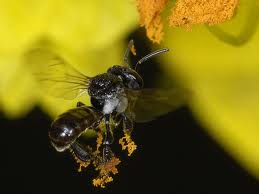

Trigona is the largest genus of stingless bees, formerly including many more subgenera than the present assemblage; many of these former subgenera have been elevated to generic status. There are approximately 150 species presently included in the genus, in 11 subgenera. They differ from those groups now excluded in only minor structural details, primarily of the hind leg.
Stingless bee, or simply meliponines, are a large group of bees, comprising the tribe Meliponini ( sometimes called stingless honey bees ) in the family Apidae, and closely related to the common honey bees, carpenter bees, orchid bees and bumblebees.
Stingless bees usually nest in hollow trunks, tree branches, underground cavities, or rock cavities, old rubbish bins, water meters, and storage drums. Many beekeepers keep the bees in their original log hive or transfer them to a wooden box, as this makes it easier to control the hive.
Stingless bees are active all year round, although they are less active in cooler weather. Unlike other eusocial bees, they do not sting but will defend by biting if their nest is disturbed. In addition, a few ( in the genus Oxytrigona ) have mandibular secretions that cause painful blisters. Despite their lack of a sting, stingless bees, being eusocial may have vary large colonies made formidable by way of numerous defends.
Stingless bees store their aromatic honey in clusters of small resin pots near the extremities of the nest. Stingless bee honey has a distinctive "bush" taste - a mix of sweet and sour with a hint of fruit. The taste comes from plant resins - which the bees use to build their hives and honey pots - and varies at different times of year depending on the flowers and tree visited
Tidak ada komentar:
Posting Komentar